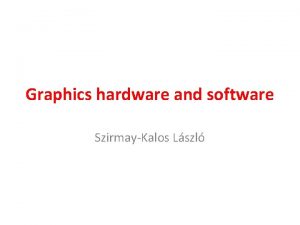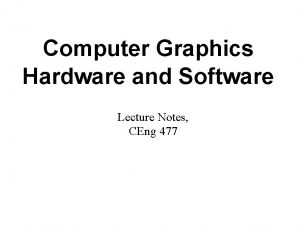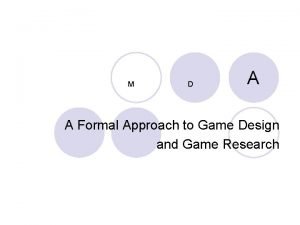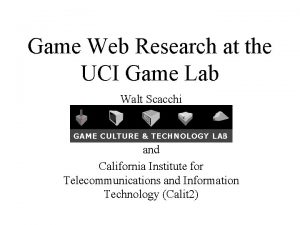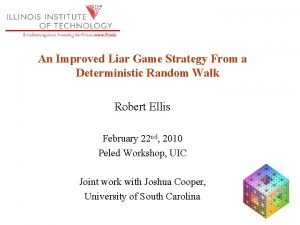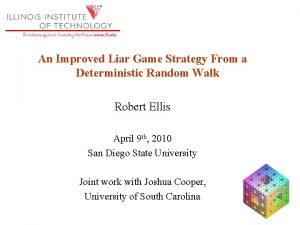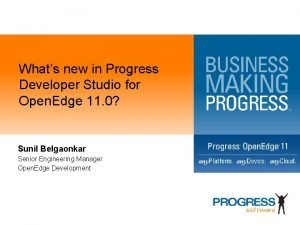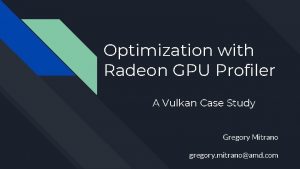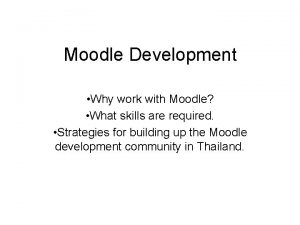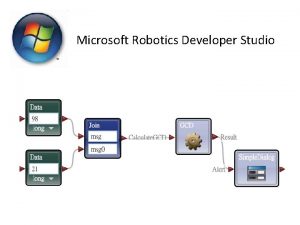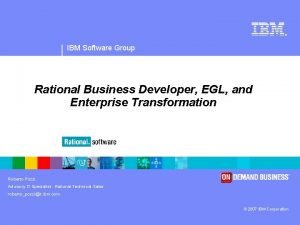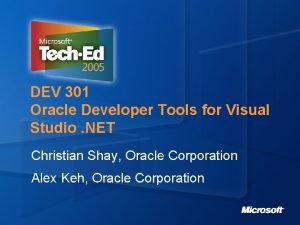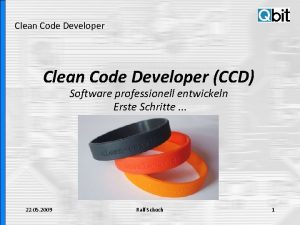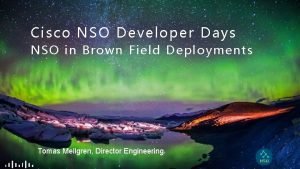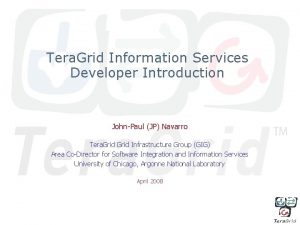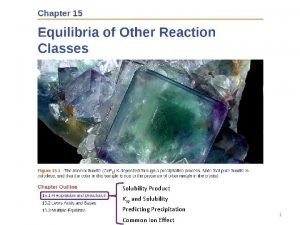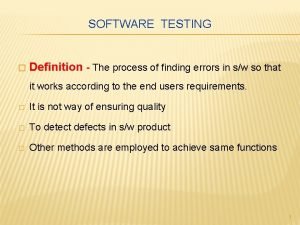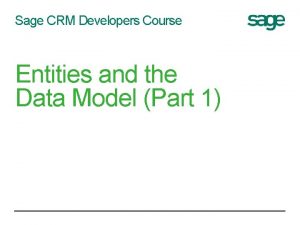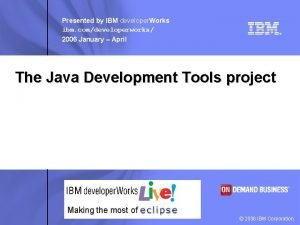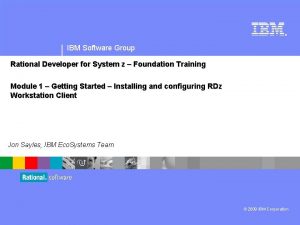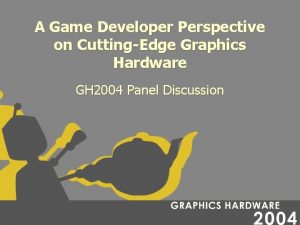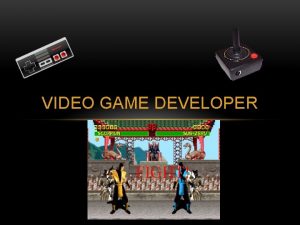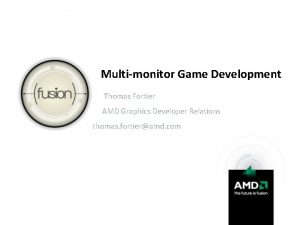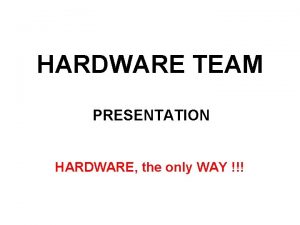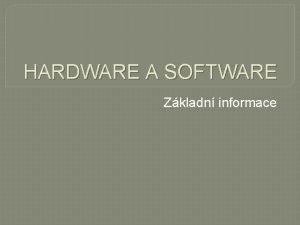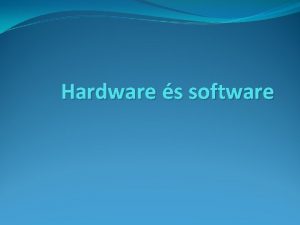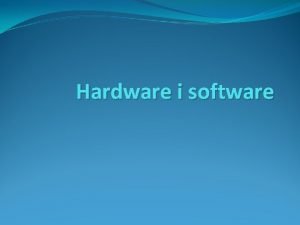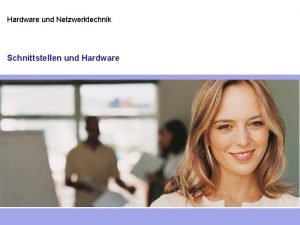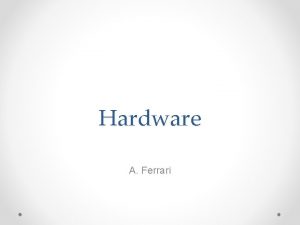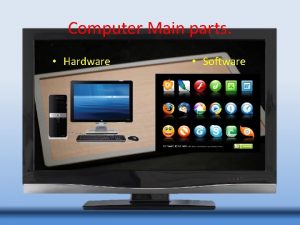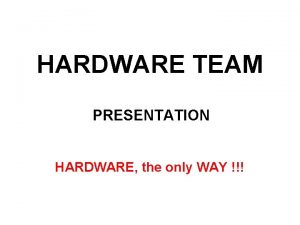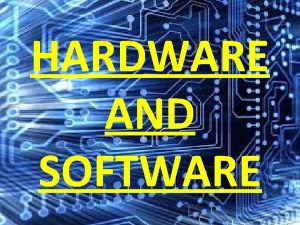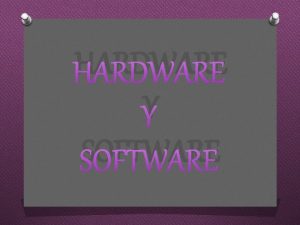A Game Developer Perspective on CuttingEdge Graphics Hardware










































- Slides: 42

A Game Developer Perspective on Cutting-Edge Graphics Hardware GH 2004 Panel Discussion

Panelists • • • Rune Vendler, Lionhead Studios Julien Merceron, Ubisoft Entertainment Rémi Arnaud, Sony R&D Moderator • Mark Harris, NVIDIA

Rune Vendler Technical Lead, Lionhead Studios Rune is currently leading the development of a major unannounced title. Prior to this, he was Head of R&D at Lionhead, and has contributed to the Black and White series (PC) and Fable (Xbox). Rune has logged eight years in the games industry. His background is in simulation and rendering, but the diverse nature of Lionhead's games have led him into artificial intelligence work as well.

A Game Developer Perspective on Cutting-Edge Graphics Hardware Rune Vendler, Lionhead Studios Graphics Hardware 2004

Interesting times • Graphics hardware is growing up • • • Doubling in speed roughly every 9 months Growing and maturing an impressive set of features Consumer hardware is no longer just a graphics accelerator toy • It is rapidly becoming a new class of processor: the stream processor • Tailored for parallel processing of independent data • With its own performance characteristics

Freedom to be different • Three shader models • • • More operations More resources More precision • We are no longer constrained to fixed graphics algorithms • We can be creative: • Custom lighting, shadowing, animation algorithms • More outlandish ideas: physics, collision, maths • The goal is games that are beautiful and unique

Disappointing results • Have games really embraced this? • No - so far, the use of programmable shading has overall been fairly superficial • Why? • Games take a long time to make • Requirements and design for graphics might already be fixed • Games require robust, generic solutions • Ideally easy to integrate into an existing codebase

This will change • We do follow what is happening in academic institutions and research labs • And it does filter down to the games • Many techniques just aren’t quite ready yet • Unless you are willing to design your game with them in mind

Promising techniques • An imaginary next-generation engine, 2006/2007 timeframe • Roughly 3 x 9 months = 8 x GPU power • Techniques to investigate, problems to tackle: • • • Precomputed radiance transfer Generalised shadowing Global illumination Occlusion testing Order-independent transparency

Almost there • GPUs have come a long way, but there is still a little left to go: • Complete set of precision modes • Orthogonality of feature set • Generalisation of resources • Virtualization of memory • Better performance

Conclusion • The games industry is embracing new graphics hardware and techniques, but big steps often only happen between each generation of games • Next generation is first to be designed wholly around programmable hardware • This will mean a considerable difference in how that hardware is used • These are indeed interesting times!

Julien Merceron Worldwide Technical Director, Ubisoft Entertainment Julien started developing on the Atari Jaguar in 1993 at Shen in Paris. He joined Ubisoft Entertainment in 1994 as a programmer for Rayman for the Jaguar and Playstation. Since then he has worked on many titles for Ubisoft. Julien is fond of hardware architecture, programming languages and algorithms, and loves designing game engines and production pipelines.

A Game Developer Perspective on Cutting-Edge Graphics Hardware Julien Merceron Worldwide Technical Director Ubisoft Ent.

• Graphics evolution on PC: • From Geforce 2 (early 2000)… » 0. 18 micron technology, 25 Million transistors; » 25 Million Polygons per second; » No shaders; • … to Ge. Force FX (early 2003): » 0. 13 micron technology, 125 Million transistors; » 200 Million Polygons per second; » 2. 0 shaders. • Graphics Hardware is in constant evolution… • » » »

• PC Graphic Hardware – Doom 3 wouldn’t be there; – Shortens innovation cycles; – PC competitive/synchronous with console. • The will to innovate is there – Sources of inspiration everywhere; – Huge eye candy & gameplay potential. • Staying on the cutting edge – (difficult) but pays • Strong selling point; • Strong development basis; • Easier generation transitions.

• Today: – Nice shadows • Shadow buffer – – Adaptive Attenuated Alpha sensitive Soft – Per pixel lighting • FP resolution – HDR becomes possible • Pixel processing power • Actual Shader capabilities – Cinematic effects • Full screen z-buffer depth of field • Motion blur • Color alteration – Polygonal geometry • For runtime

• Not close enough to CG rendering quality – Memory still limits: • Texture types & resolution • FSAA – New lighting / material interaction models – World Animation at Runtime

• Inner frame computing: • Graphic Sub-sampling • Animation detail appears even at high speed • High animation production values needed

Images Copyright Pixar



• Solving that completely: • More Processing power • Hardware Transparency sorting




• Tessellation according to distance and normal maps;

Rémi Arnaud Graphics architect, Sony Computer Entertainment America Rémi started in the R&D team of Thomson Training & Simulation, and then moved to SGI where he worked on the Performer API. He co-founded Intrinsic Graphics after it became clear that the same software issues he solved for high-end customers at SGI would now apply to the videogame industry. Rémi now leads development of next-generation graphics APIs at Sony. Rémi received a Ph. D from the Pierre & Marie Curie University in Paris in 1994.

Sony US R&D • Foster City, California • Next generation Playstation R&D • 35 people • Several projects • • • Lots of internal projects eye. Toy COLLADA

HW Side Effects… • • • Content complexity Content size Larger teams Shrinking production schedule New specialized jobs (shaders) Development tools yet to be invented

Current model Source DCC tool Exporter Fast Path Viewer App. data Intermediate Dev. Tools Conversion Final asset script Application

Communication deficiency • • No existing standard interchange format • Source data in DCC proprietary format • No collaboration to create such format • Too much work creating exporters • Content creativity limited by lack of this technology Import is equally or more important than export Need validation capability • Syntax to be validated, regardless of the content • Need to enable verification of exporter and importer quality Need real interchange capability • Can use a variety of tools • No loss. Can be used as source data • Opening the door to a variety of specialized tools

Introduction to COLLADA: COLLAborative Design Activity • Sony Computer Entertainment US R&D project • ‘Open-Source’ project • No string attached / no hidden agenda • Multi-platform, for all targets • Work started exactly a year ago at Sig. Graph’ 03 • Sig. Graph’ 04 • COLLADA 1. 0 specifications • ‘Open Source’ COLLADA (www. collada. org) • COLLADA 1. 1 later this year • GDC’ 05 • COLLADA 1. 2 • Feature list depend on feedback

Current contributors • SCEA, SCEE, SCEI, Naughty Dog, Insomniac, … • DCC tools: • Alias*, Discreet*, Softimage*, … • Middleware: • Criterion*, Havok, Hybrid, Quazal, Emdigo*, Metrowerks, Novodex*, Virtools, Vicarious Visions, … • Game Developers • Digital Eclipse, Electronic Arts, Epic, Secret Level, UBIsoft, Vicarious Visions*, … • Movie Industry • dnahelix, PDI/Dream. Works, … * Presented at Sig. Graph

What makes COLLADA? COLLADA specification document XML schema, used to validate COLLADA files Source code for: • Open. GL viewer, with Cg 1. 2 support • Reference code not intended for production • For Windows, Linux and Max. OS • Sample data and utilities • DCC Importer/Exporter directly from vendor • 3 DMax, Maya, XSI www. collada. org/2004/COLLADASchema

COLLADA model DCC tools Import/Export 3 rd party tools Assets App. data COLLADA Dev. Tools Fast Path Viewer script Schema Validation Conversion Final asset Application

COLLADA 1. 0 requirements • Include all the major features • Geometry, Hierarchy • Materials, Textures, Shaders, Lights, Camera • Techniques, multi representation, assets • Accepted and supported by the major DCC vendors • Alias, Discreet and Softimage • Validated with developers • Lots of feedback incorporated • Need acceptance • Collecting feedback from public forum

Pandora box opened • Conformance Test • Missing even from 1. 0 release • Dynamic content • Animations • Physics • Asset management • Still working on files • Element asset management • Distribution model • Real database storage • Distributed content • Shader development • Cg ? HLSL ? GLSL ? Sh ? • Low level interface ? • Need development tools (IDE? Specialized tools? )

Contact information remi@playstation. sony. com collada@collada. org www. collada. org

Q&A

Research • Graphic research shows the way to go; • See solved: • Use our knowledge to get the effect without the cost of it. • Dev/art constraint: getting rid of dealing explicitely with transparency: • No sorting issues anymore; • Allows per pixel alpha sensitive materials. • Getting closer to CG: • No more pixel Color saturation; • Texture Resolution & adv. filtering & fsaa; • Inner-frames computing & blur. (see next slide for technical explanations, but illustrations & general explanations will be here) • Soft shadowing • New lighting / material interaction models • From R&D to integration: • • • Working closer (always helps); Use of software standards; Use of game hardware.

Graphics Hardware • Latest most significant improvements: • Floating point resolution for computations. • Less saturation, more per pixel effects. • WGF architecture • Looking forward to see: • Crazy idea that will change games look 10 years from now: • HDR « free » in f 32 f 32 format. • Inner frame computing: N frames created for one displayed with per pixel blur blending. • Determine N based on inner-frames animation key frame densities & physical object trajectories (to avoid obvious artefacts); • Sub sampling as you do with physics/collisions; • Will require high quality animation, what should be true in 2 console generations time frame; • From a hardware architecture standpoint we’re almost there, but from a processing power one we’re not. • Real-time tesselation according to normal map informations on the silhouette.

Games • From the beginning of 3 D until now: • Lighting: • Geometry & material aspects were statically hand-drawn in the color textures; • Lightmaps appeared along with texture projection shadowing; • Color texture + normal map + height map + gloss map + light map + occlusion maps + shadow buffer techniques => per pixel shadowed virtual displacement mapping ( parallax mapping) • Materials: • Next steps: • Making materials react as they look: coherency. • Coherency appears in games. • Lighting: • Per pixel self shadowing: • Angle & horizon maps for pp diffuse self shadowing? • PP Spherical harmonics? • Advanced models for lighting. • Materials: • You look like you sound and you behave.
 Graphics hardware in computer graphics ppt
Graphics hardware in computer graphics ppt Internal and external hardware
Internal and external hardware Vbo1
Vbo1 What is computer
What is computer Hand held computer
Hand held computer One point perspective lettering
One point perspective lettering Silo perspective vs business process perspective
Silo perspective vs business process perspective Pirate game sheet
Pirate game sheet Rules for the farming game
Rules for the farming game A formal approach to game design and game research
A formal approach to game design and game research Game lab game theory
Game lab game theory Liar game game theory
Liar game game theory Liar game game theory
Liar game game theory Progress developer studio for openedge download
Progress developer studio for openedge download Us bank api
Us bank api T shaped developer
T shaped developer Sitecore modules
Sitecore modules Saints row 2 phillips building
Saints row 2 phillips building Fase developer
Fase developer Rgp
Rgp Moodle developers
Moodle developers Microsoft robotics developer
Microsoft robotics developer Microsoft certified solutions developer app builder
Microsoft certified solutions developer app builder Oracle developer terdiri dari
Oracle developer terdiri dari Egl software
Egl software Computer science vs software engineering
Computer science vs software engineering Visual studio code oracle sql
Visual studio code oracle sql Clean code developer
Clean code developer Nso developer
Nso developer Blackboard learn api
Blackboard learn api Asp net core roadmap
Asp net core roadmap Oracle developer forms
Oracle developer forms Qwop developer
Qwop developer Tera jp
Tera jp Ksp solubility relationship
Ksp solubility relationship Process of finding errors in software code
Process of finding errors in software code Sage crm developer guide
Sage crm developer guide Mysql developer download
Mysql developer download Ibm developerworks java
Ibm developerworks java Who invented physical education
Who invented physical education Ms teams developer platform
Ms teams developer platform Linq guernsey
Linq guernsey Rational developer for system z
Rational developer for system z


